2016 TOYOTA MIRAI ECU
[x] Cancel search: ECUPage 367 of 464
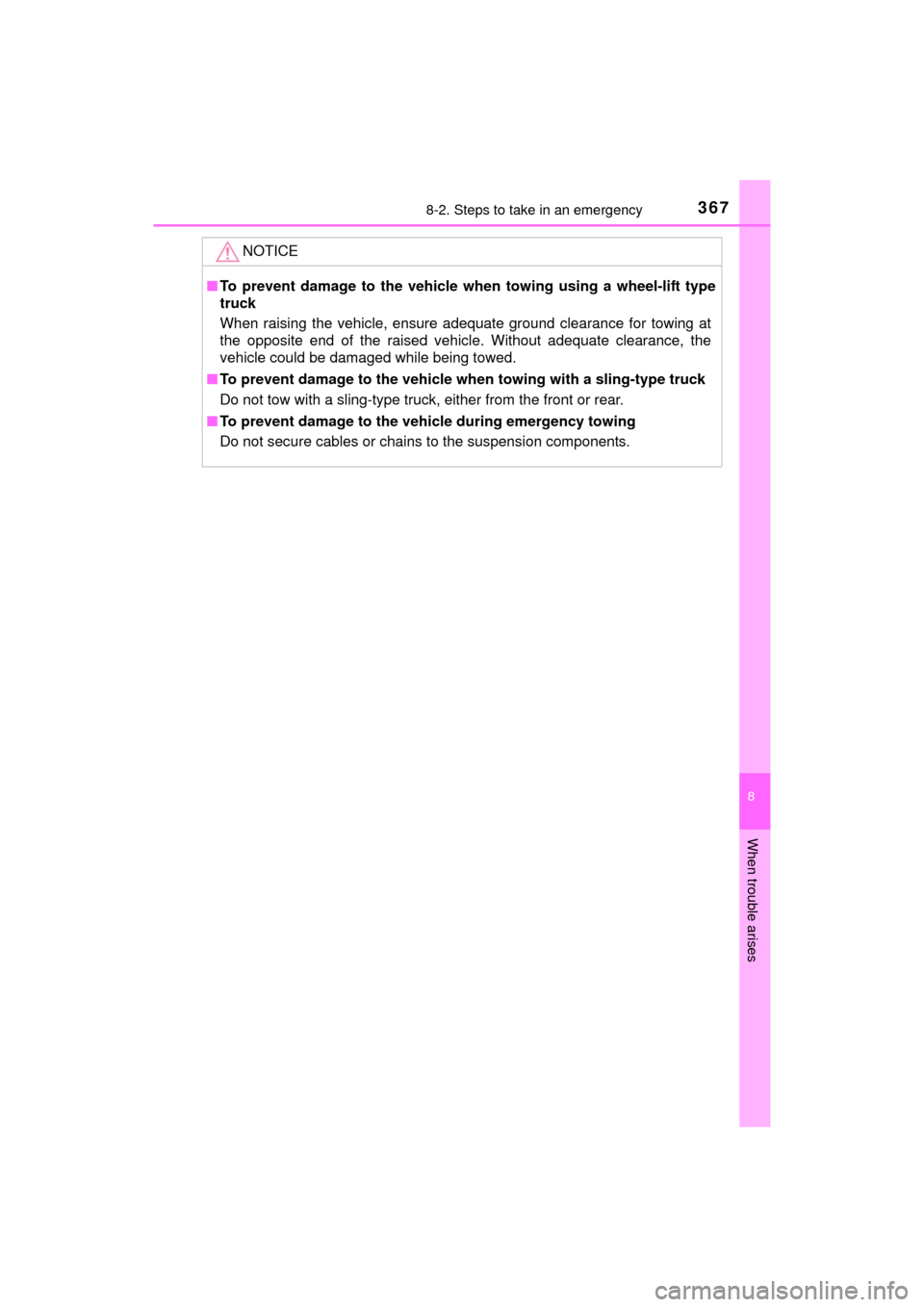
3678-2. Steps to take in an emergency
MIRAI_OM_USA_OM62004U
8
When trouble arises
NOTICE
■To prevent damage to the vehicle when towing using a wheel-lift type
truck
When raising the vehicle, ensure adequate ground clearance for towing at
the opposite end of the raised vehicle. Without adequate clearance, the
vehicle could be damaged while being towed.
■ To prevent damage to the vehicle wh en towing with a sling-type truck
Do not tow with a sling-type truck, either from the front or rear.
■ To prevent damage to the vehic le during emergency towing
Do not secure cables or chains to the suspension components.
Page 373 of 464
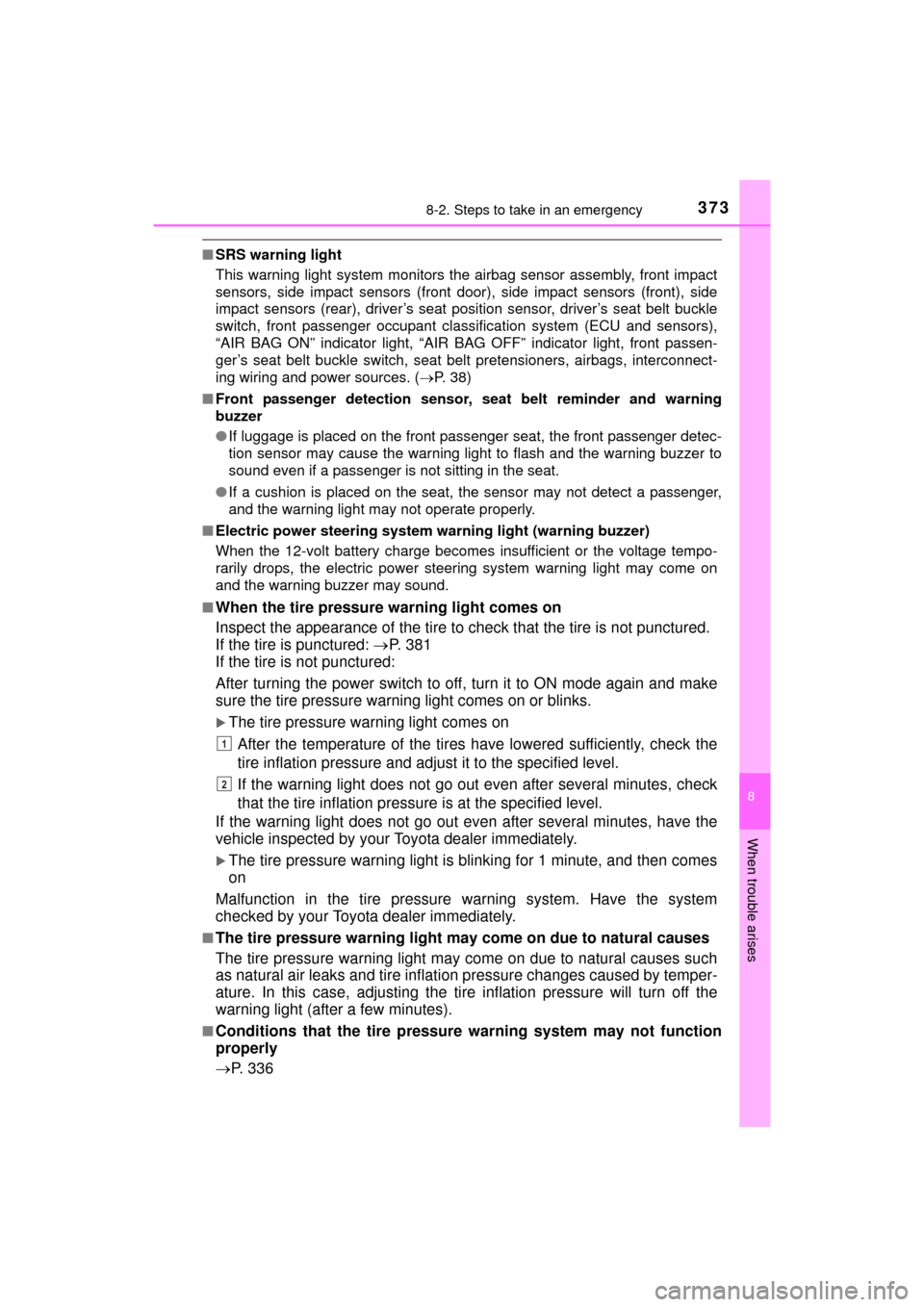
3738-2. Steps to take in an emergency
MIRAI_OM_USA_OM62004U
8
When trouble arises
■SRS warning light
This warning light system monitors the airbag sensor assembly, front impact
sensors, side impact sensors (front door), side impact sensors (front), side
impact sensors (rear), driver’s seat position sensor, driver’s seat belt buckle
switch, front passenger occupant cla ssification system (ECU and sensors),
“AIR BAG ON” indicator light, “AIR BAG OFF” indicator light, front passen-
ger’s seat belt buckle switch, seat belt pretensioners, airbags, interconnect-
ing wiring and power sources. ( P. 38)
■ Front passenger detection sensor, seat belt reminder and warning
buzzer
● If luggage is placed on the front passenger seat, the front passenger detec-
tion sensor may cause the warning light to flash and the warning buzzer to
sound even if a passenger is not sitting in the seat.
● If a cushion is placed on the seat, the sensor may not detect a passenger,
and the warning light may not operate properly.
■ Electric power steering system warning light (warning buzzer)
When the 12-volt battery charge becomes insufficient or the voltage tempo-
rarily drops, the electric power steering system warning light may come on
and the warning buzzer may sound.
■
When the tire pressure warning light comes on
Inspect the appearance of the tire to check that the tire is not punctured.
If the tire is punctured: P. 381
If the tire is not punctured:
After turning the power switch to off, turn it to ON mode again and make
sure the tire pressure warning light comes on or blinks.
The tire pressure warning light comes on
After the temperature of the tires have lowered sufficiently, check the
tire inflation pressure and adjust it to the specified level.
If the warning light does not go out even after several minutes, check
that the tire inflation pressu re is at the specified level.
If the warning light does not go out even after several minutes, have the
vehicle inspected by your Toyota dealer immediately.
The tire pressure warning light is blinking for 1 minute, and then comes
on
Malfunction in the tire pressure warning system. Have the system
checked by your Toyota dealer immediately.
■The tire pressure warning light may come on due to natural causes
The tire pressure warning light may come on due to natural causes such
as natural air leaks and tire inflation pressure changes caused by temper-
ature. In this case, adjusting the ti re inflation pressure will turn off the
warning light (after a few minutes).
■Conditions that the tire pressure warning system may not function
properly
P. 3 3 6
1
2
Page 378 of 464

3788-2. Steps to take in an emergency
MIRAI_OM_USA_OM62004U■
If “Press Brake When Vehicle is St opped FC System may Overheat” is
displayed
Message is displayed when the accelerator pedal is depressed to maintain
the vehicle position when stopped on an upward slope, etc.
If this continues, the fuel cell system may overheat.
Release the accelerator pedal and depress the brake pedal.
■ If “Accelerator Pedal is Pressed Ch eck The Accelerator Pedal” is dis-
played
The accelerator pedal may be stuck.
If the message does not disappear even when the foot has been removed
from the accelerator pedal, check that the accelerator pedal is not stuck.
■ If “Ion Filter Maintenance Require d Visit Your Dealer” is displayed
Ion filter replacement is necessary. Contact your Toyota dealer.
■ If “Shift System Malfunction Stop Your Vehicle in a Safe Place then See
Owner's Manual” is displayed
The shift position may not be able to be shifted. Stop the vehicle in a safe
place.
Contact your Toyota dealer immediately.
■ If “Shift System Malfunction Shifting Unavailable See Owner’s Manual”
is displayed
The shift position may not be able to be shifted from P to a position other than
P.
Contact your Toyota dealer immediately.
■ If “Shift System Malfunction When Parking, Apply Parking Brake
Securely then See Owner’s Manual” is displayed
●The parking lock mechanism may not operate.
● The automatically P position selection function ( P. 177) may not operate.
● The power switch may not turn off. In that case, engage the parking brake
and the switch can be turned to off.
● The fuel cell system may not be able to be started.
When parking, choose a flat surface and be sure to engage the parking
brake.
Have the vehicle inspected by your Toyota dealer immediately.
Page 379 of 464
![TOYOTA MIRAI 2016 1.G Owners Manual 3798-2. Steps to take in an emergency
MIRAI_OM_USA_OM62004U
8
When trouble arises
■If “[P] Switch Malfunction When Parking, Apply Parking Brake Securely
then See Owner’s Manual” is displayed
TOYOTA MIRAI 2016 1.G Owners Manual 3798-2. Steps to take in an emergency
MIRAI_OM_USA_OM62004U
8
When trouble arises
■If “[P] Switch Malfunction When Parking, Apply Parking Brake Securely
then See Owner’s Manual” is displayed](/manual-img/14/6549/w960_6549-378.png)
3798-2. Steps to take in an emergency
MIRAI_OM_USA_OM62004U
8
When trouble arises
■If “[P] Switch Malfunction When Parking, Apply Parking Brake Securely
then See Owner’s Manual” is displayed
The shift position may not switch to P even though the P position switch is
pressed.
When parking, choose a flat surface and be sure to engage the parking
brake.
Have the vehicle inspected by your Toyota dealer immediately.
■ If “Shift System Malfunction See Owner’s Manual” is displayed
If left as is, the system may not operate properly and an unexpected hazard
or damage may occur.
Have the vehicle inspected by your Toyota dealer immediately.
■ If “Insufficient Aux Battery Charge When Parking, Apply Parking Brake
Securely then See Owner’s Manual” is displayed
●The parking lock mechanism may not operate.
● The power switch may not turn off. In that case, engage the parking brake
and the switch can be turned to off.
● Even after charging the 12-volt battery, the warning message may continue
to be displayed until the shift position is shifted from P to a position other
than P.
● The fuel cell system may not be able to be started.
When parking, choose a flat surface and be sure to engage the parking
brake.
Have the 12-volt battery charged or replaced.
■ If “Insufficient Aux Battery Charge Shift is Unavailable See Owner’s
Manual” is displayed
Due to the voltage of the 12-volt battery being in a declined condition, when
trying to shift the shift position the warning message is displayed.
Have the 12-volt battery charged or replaced.
■ If “Shifting Temporarily Unavailable Wait a Moment and Try Again” is
displayed
A warning message is displayed when the shift lever and P position switch
are repeatedly operated over a short period of time.
Shift the shift position after waiting for short amount of time.
■ If “Shifting to [Br] Mode Unavailable Shift to [D] once, then Shift to [Br]”
is displayed
When the shift position is in P or N, a warning message is displayed when try-
ing to shift to Br mode.
Shift to Br mode after the shift position had been set to D.
■ If “Shifted to [N] Position Shift to [D] once, then Shift to [Br]” is dis-
played
When the shift position is in R, a warning message is displayed when trying to
shift to Br mode.
The shift position is changed to N.
Shift to Br Mode after the shift position has been set to D.
Page 386 of 464
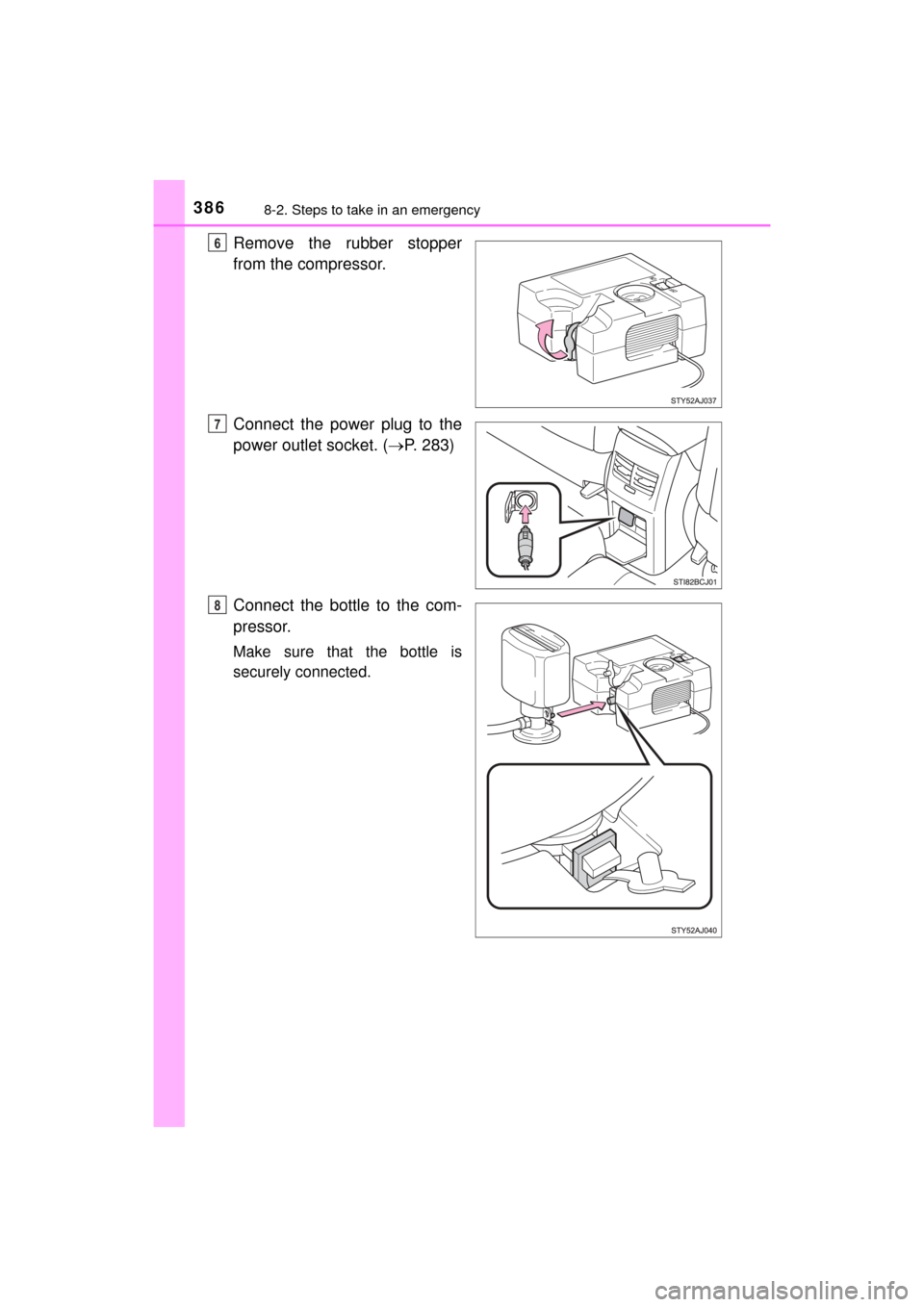
3868-2. Steps to take in an emergency
MIRAI_OM_USA_OM62004U
Remove the rubber stopper
from the compressor.
Connect the power plug to the
power outlet socket. (P. 283)
Connect the bottle to the com-
pressor.
Make sure that the bottle is
securely connected.
6
7
8
Page 393 of 464
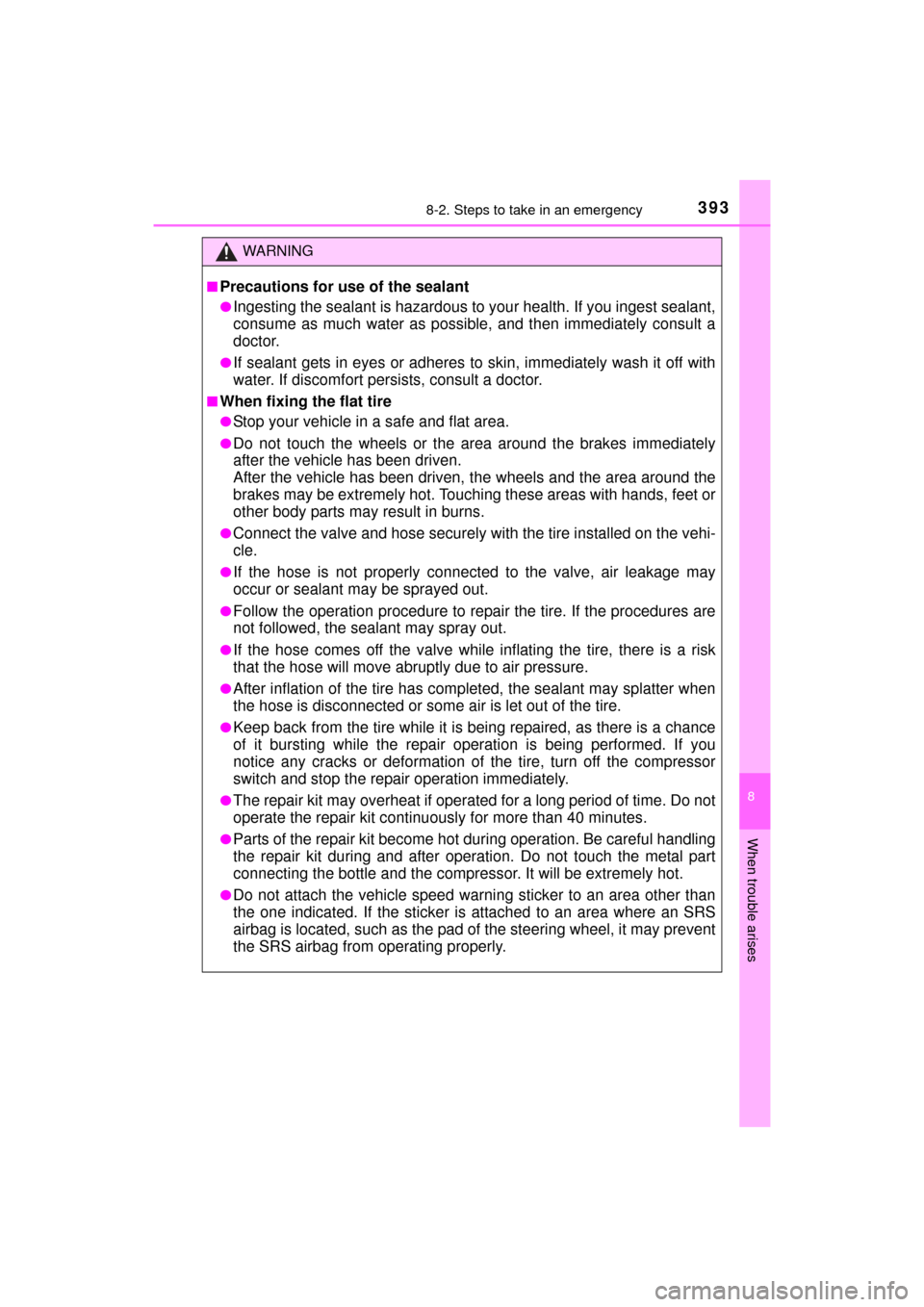
3938-2. Steps to take in an emergency
MIRAI_OM_USA_OM62004U
8
When trouble arises
WARNING
■Precautions for use of the sealant
●Ingesting the sealant is hazardous to your health. If you ingest sealant,
consume as much water as possible, and then immediately consult a
doctor.
●If sealant gets in eyes or adheres to skin, immediately wash it off with
water. If discomfort persists, consult a doctor.
■When fixing the flat tire
●Stop your vehicle in a safe and flat area.
●Do not touch the wheels or the ar ea around the brakes immediately
after the vehicle has been driven.
After the vehicle has been driven, the wheels and the area around the
brakes may be extremely hot. Touchi ng these areas with hands, feet or
other body parts may result in burns.
●Connect the valve and hose securely with the tire installed on the vehi-
cle.
●If the hose is not properly connec ted to the valve, air leakage may
occur or sealant ma y be sprayed out.
●Follow the operation procedure to repair the tire. If the procedures are
not followed, the sealant may spray out.
●If the hose comes off the valve while inflating the tire, there is a risk
that the hose will move abru ptly due to air pressure.
●After inflation of the tire has completed, the sealant may splatter when
the hose is disconnected or some air is let out of the tire.
●Keep back from the tire while it is being repaired, as there is a chance
of it bursting while the repair op eration is being performed. If you
notice any cracks or deformation of the tire, turn off the compressor
switch and stop the repair operation immediately.
●The repair kit may overheat if operated for a long period of time. Do not
operate the repair kit continuously for more than 40 minutes.
●Parts of the repair kit become hot during operation. Be careful handling
the repair kit during and after operation. Do not touch the metal part
connecting the bottle and the compressor. It will be extremely hot.
●Do not attach the vehicle speed warning sticker to an area other than
the one indicated. If the sticker is attached to an area where an SRS
airbag is located, such as the pad of the steering wheel, it may prevent
the SRS airbag from operating properly.
Page 404 of 464

4048-2. Steps to take in an emergency
MIRAI_OM_USA_OM62004U■
When exchanging the 12-volt battery
Use a Central Degassing type 12-volt battery (Japanese Industrial Stan-
dards). Also, use 12-volt batteries with case sizes similar to one prior the
exchange and an equivalent 20 hour rate capacity (20HR) or greater.
• If the sizes differ, the 12-volt battery cannot be properly secured.
• If the 20 hour rate capacity is low, even if the time period where the vehicle
is not used is a short time, the 12-volt battery may discharge and fuel cell
system may not be able to start.
For details, consult your Toyota dealer.
WARNING
■ Avoiding 12-volt battery fires or explosions
Observe the following precautions to prevent accidentally igniting the flam-
mable gas that may be emitted from the 12-volt battery:
●Make sure each jumper cable is connected to the correct terminal and that
it is not unintentionally in contact with any other than the intended terminal.
● Do not allow the other end of the jumper cable connected to the “+” termi-
nal to come into contact with any other parts or metal surfaces in the area,
such as brackets or unpainted metal.
● Do not allow the + and - clamps of the jumper cables to come into contact
with each other.
● Do not smoke, use matches, cigarette lighters or allow open flame near
the 12-volt battery.
■ 12-volt battery precautions
The 12-volt battery contains poisonous and corrosive acidic electrolyte,
while related parts contain lead and lead compounds. Observe the following
precautions when handling the 12-volt battery:
●When working with the 12-volt battery, always wear safety glasses and
take care not to allow any 12-volt battery fluids (acid) to come into contact
with skin, clothing or the vehicle body.
● Do not lean over the 12-volt battery.
● In the event that 12-volt battery fluid comes into contact with the skin or
eyes, immediately wash the affected area with water and seek medical
attention.
Place a wet sponge or cloth over the affected area until medical attention
can be received.
● Always wash your hands after handling the 12-volt battery support, termi-
nals, and other battery-related parts.
● Do not allow children near the 12-volt battery.
Page 405 of 464
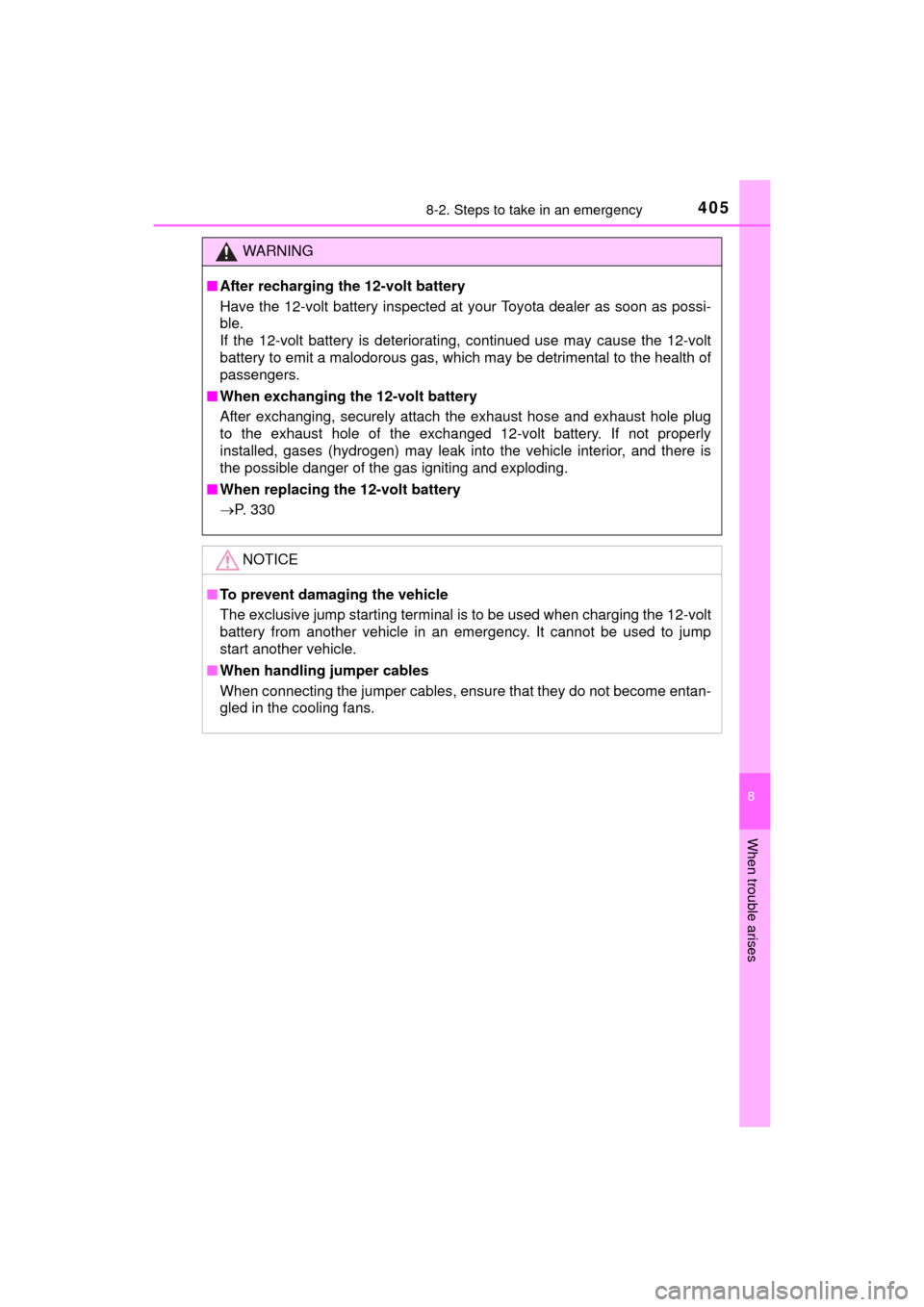
4058-2. Steps to take in an emergency
MIRAI_OM_USA_OM62004U
8
When trouble arises
WARNING
■After recharging the 12-volt battery
Have the 12-volt battery inspected at your Toyota dealer as soon as possi-
ble.
If the 12-volt battery is deteriorating, continued use may cause the 12-volt
battery to emit a malodorous gas, which may be detrimental to the health of
passengers.
■ When exchanging the 12-volt battery
After exchanging, securely attach the exhaust hose and exhaust hole plug
to the exhaust hole of the exchanged 12-volt battery. If not properly
installed, gases (hydrogen) may leak into the vehicle interior, and there is
the possible danger of the gas igniting and exploding.
■ When replacing the 12-volt battery
P. 330
NOTICE
■To prevent damaging the vehicle
The exclusive jump starting terminal is to be used when charging the 12-volt
battery from another vehicle in an emergency. It cannot be used to jump
start another vehicle.
■ When handling jumper cables
When connecting the jumper cables, ensure that they do not become entan-
gled in the cooling fans.